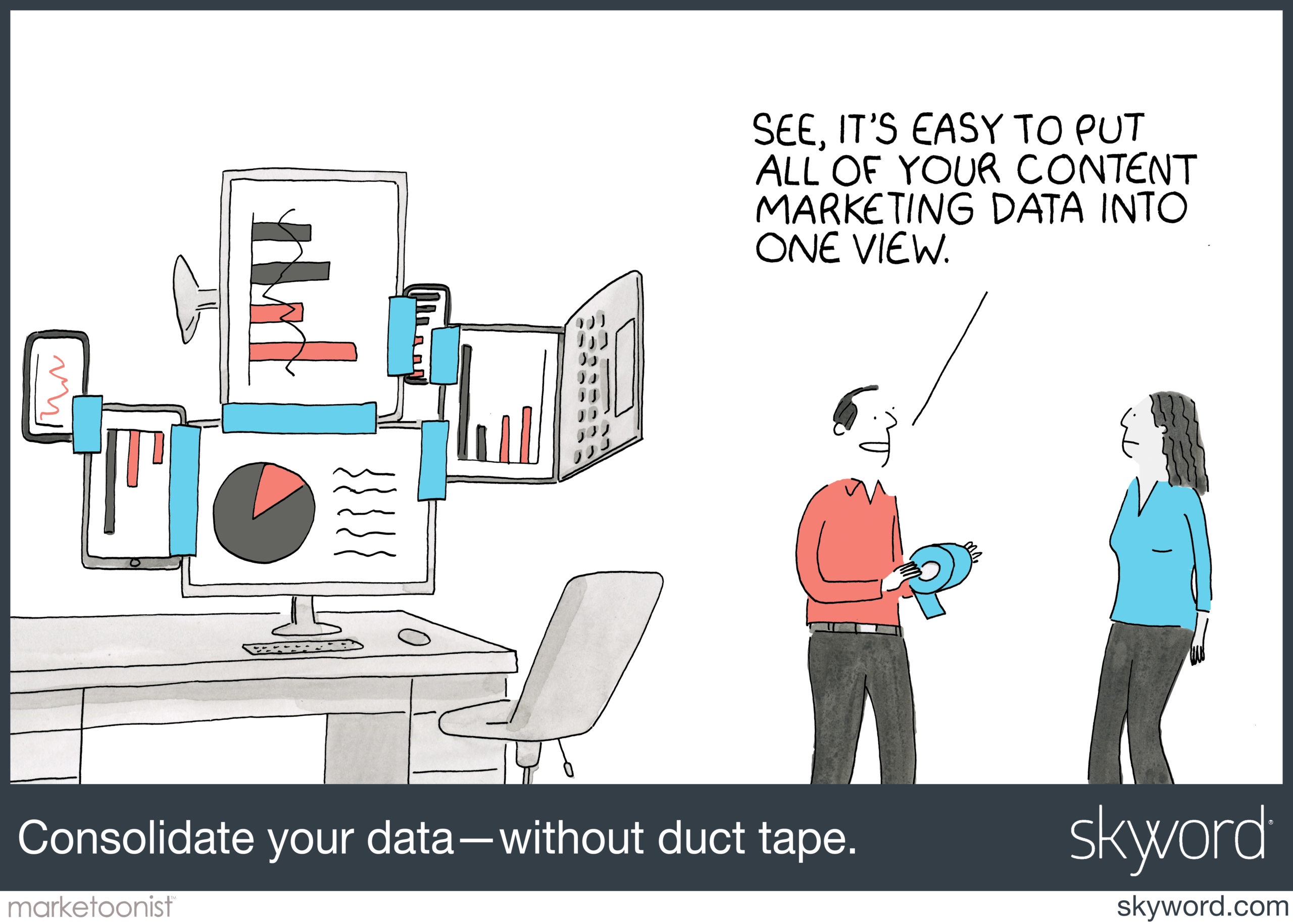Creativity
The Seven Needs of a Content-Centric Marketing Organization, Part Seven: Optimize
By Steph Ferrell on November 5, 2018
This article is Part Seven of a series on the needs of a content-centric marketing organization. Read the full series for more coverage.
Your deadline is Monday morning, and it's currently Friday afternoon. You're sitting at your desk, staring out the window, and thinking about how to deliver a report that will prove your efforts are worth it (no pressure).
Many content marketers have longed for their own "Zuckerburg in his college dorm room moment": the one where you pick up a Sharpie, scribble all over the window, and-voilà!-understand the ROI of your content strategy perfectly.
Except that's usually not what happens. Content marketing data is scattered across different platforms and defined in different ways by various stakeholders-all making ROI feel more like an unattainable illusion than a number your work's value relies on.
Comforting, right?
The difficulty of measuring ROI is a pain felt by many marketers: according to The Content Marketing Institute's 2017 research, 47 percent of B2B marketers and 43 percent of B2C marketers do not measure ROI. Why? Because they either think it's too hard, feel it's too time-consuming, or don't know where to start.
To be clear: it's not that the data isn't there. Skyword's 2018 research of nearly 1,000 marketers found that 82 percent had metrics in place to assess content performance. In fact, the top marketers were tracking traffic, engagement, and goal conversions-all the way down to sales attribution. Yet, ROI can still feel elusive. The challenge is that data is most definitely there-but it's here, there, and everywhere, scattered across what can feel like an infinite number of channels.
Searching for the Big Picture
From the era of Madison Avenue advertising to today's digital world, measuring marketing ROI has never been easy. In the 1960s, ROI was largely an over-simplified sales analysis: did sales increase after running a certain amount of ads in a certain amount of places? Predictably, tying marketing to a broad sales metric like that was problematic in that it didn't account for any confounding variables.

Then, the birth of digital advertising presented hope for marketing ROI and held marketing practices more accountable: so accountable that when paid ads began to yield only nominal click-through rates, the industry was left scrambling for alternatives.
Enter: content. Content marketing surfaced as a promising alternative to advertising-it was new and exciting, and marketers had a grace period in which they could be trailblazers with no fear. Metrics like pageviews and engagement sufficed for progress, and marketing teams were placated by the excitement of a new venture.
A Whole Lot of Data
But over time, the breadth of content marketing has expanded: content now spans all digital channels, from social to email to sales enablement and more. This expansion in scope is happening at the same time that marketing teams are realizing the true power of content and doubling down on accountability. With large investments that put content at the core of all marketing, it's not enough to just execute and count pageviews.
And while more activation channels are exciting for their potential, these channels only introduce even more variables and data into the ROI equation. That leaves marketers empowered to produce but overwhelmed to prove, rich in data but not in insight.
With so many campaigns running to complement one another and support business objectives, getting ROI and attribution correct is a matter of keeping all of your many efforts and operations airtight, from the strategy all the way to the measurement and optimization of that strategy. Marketers must be strategic in their KPI distinctions and diligent in their tracking mechanisms. They must feel unified and confident in those KPI definitions and measurement tactics, and they must be able to analyze them and deduce insights from them without drowning in numbers.
Use Data to Inform Strategy
It's one thing to create a strategy, but another to devise a smart, data-informed strategy. Your data is now scattered across many different channels, and that means so is your competitors'. It can be incredibly difficult to understand industry best practices or benchmark against competitor performance, but this information is absolutely vital in creating a strategy that will lead to the ROI marketing teams hope for. Having this kind of insight will also allow you to set realistic expectations when predicting that ROI. Marketing insight tools exist to help with this type of strategy optimization, so that when your boss states one of your goals should be an unrealistic, far-above-industry-standard ROI on your paid social efforts, you can show her the data to recommend otherwise.
Define KPIs Clearly
One of the most important steps in managing data and expectations is to clearly define KPIs for every stage in your content strategy. Without a clear goal and KPI associated with every piece of content you create, your strategy will begin to fall in on itself when it's time to report back on its execution.
Clearly defining KPIs means every stakeholder must agree on what terms like "awareness," "engagement," and "conversion" mean to your brand-in every channel. These definitions will change across channels and will depend on that channel's goals, so it's important to sync up on these nuances across your overarching strategy. Once defined, have these definitions documented, so that there is never a question about what you're working toward and the results of those efforts.
Track Your KPIs Accordingly
With KPIs well defined, it's important to ensure you are collecting data toward those definitions. Careful and diligent tracking systems must be in place to ensure your data is reliable and provides you the numbers you need to put a story behind your efforts.
Image attribution: Anastasia Petro
While KPIs will change by channel, production KPIs largely stay constant. If you're tracking production goals across any channel, make sure you have a system in place that measures the amount of content in each stage of your strategy and the amount of content activated. Having a tool that enables you to pull reports on these kinds of metrics is extremely valuable for optimization.
Complete Visibility, Without Duct Tape
As far as content performance goes, diligent tracking means buttoning up your UTM codes, tracking tags, conversion triggers, and more-often across many different platforms. That means when it comes to analyzing those KPIs, you're doing so across many different platforms as well.
The most frustrating part about scattered data isn't only that it's overwhelming, but that it takes an enormous amount of time to wrangle. By the time you've aggregated and organized your data into the right consolidated reports (hopefully accurately), you've lost precious time that you could have spent bringing actual value to the process: the touch of human, strategic data analysis.
It's important, then, to have access to all of your data from a central location-although even with a central view, you'll likely still feel overwhelmed by the sheer amount of channel activity and data. Working with a tool that helps you cut through number noise by generating performance snapshots and providing dashboards of actionable information is one way to mitigate this issue. With these tools, the ability to drill down is always there, but without the expectation that you be the excavator.
Aggregate to Optimize
Marketers are in a position where they can reverse previous visceral reactions to data, KPIs, and ROI. While yes, multiple activation channels have further deepened the historically murky waters of marketing ROI, there are now tools to help us wade our way through.
By aggregating marketing insights, materials, and measurement into a central location, marketers will most certainly find a way to float.
Read the full series for more on the needs of a content-centric marketing organization.
Featured image attribution: TJ Dragotta


